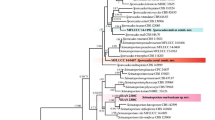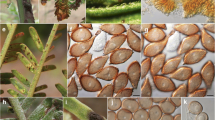Abstract
In 2002, a powdery mildew with catenate conidia lacking fibrosin bodies was found on cucumber in a greenhouse in Kanagawa Prefecture, Japan. Morphological observation revealed that the fungus belongs to Oidium subgenus Reticuloidium, anamorph of the genus Golovinomyces. Molecular phylogenetic analyses of the nucleotide sequences of the rDNA ITS regions and D1/D2 domains of the 28S rDNA indicated that the fungus belongs to the clade of G. orontii with other Golovinomyces fungi from a wide range of host plants, suggesting that the fungus was newly transported from abroad. Because there has been no prior report of cucumber powdery mildew caused by Reticuloidium, further research on the physiology, epidemiology, control and resistant cucumber varieties is required.



Similar content being viewed by others
References
Abiko K (1978) Studies on the specialization of parasitism of Sphaerotheca fuliginea (Schlecht.) Pollacci I. Powdery mildew fungi parasitic on cucurbits, eggplant, edible burdock and Japanese butterbur. Ann Phytopathol Soc Jpn 44:612–618
Abiko K (1982a) Studies on the specialization of parasitism of Sphaerotheca fuliginea (Schlecht.) Pollacci II. Powdery mildew fungi on flowering plants. Bull Veg Ornam Crops Res Stn Ser A 10:57–62
Abiko K (1982b) Studies on the specialization of parasitism of Sphaerotheca fuliginea (Schlecht.) Pollacci II. Powdery mildew fungi parasitic on weeds. Bull Veg Ornam Crops Res Stn Ser A 10:63–67
Amano K (1986) Host range and geographical distribution of the powdery mildew fungi. Japan Scientific Societies Press, Tokyo
Bardin M, Carlier J, Nicot PC (1999) Genetic differentiation in the French population of Erysiphe cichoracearum, a causal agent of powdery mildew of cucurbits. Plant Pathol 48:531–540
Blumer S (1952) Beiträge zur Spezialisation der Erysipheen (in German). Ber Schweiz Bot Ges 62:384–401
Blumer S (1967) Echte Mehltaupilze (Erysiphaceae) (in German). Gustav Fischer, Jena
Braun U (1980) Morphological studies in the genus Oidium. Flora 170:77–90
Braun U (1987) A monograph of the Erysiphales (powdery mildews). Beih Nova Hedwig 89:1–700
Braun U (1999) Some critical notes on the classification and generic concept of the Erysiphaceae. Schlechtendalia 3:49–55
Braun U, Takamatsu S (2000) Phylogeny of Erysiphe, Microsphaera, Uncinula (Erysipheae) and Cystotheca, Podosphaera, Sphaerotheca (Cystotheceae) inferred from rDNA ITS sequences—some taxonomic consequences. Schlechtendalia 4:1–33
Braun U, Shishkoff N, Takamatsu S (2001) Phylogeny of Podosphaera sect. Sphaerotheca subsect. Magnicellulatae (Sphaerotheca fuliginea auct. s. lat.) inferred from rDNA ITS sequences—a taxonomic interpretation. Schlechtendalia 7:45–52
Braun U, Cook RTA, Inman AJ, Shin HD (2002) The taxonomy of the powdery mildew fungi. In: Bélanger R, Bushnell WR, Dik AJ, Carver TLW (eds) The powdery mildews: a comprehensive treatise. APS Press, St. Paul, pp 13–55
Endo T (1989) Studies on the life-cycle of cucurbit powdery mildew fungus Sphaerotheca fuliginea (Schlecht.) Poll (in Japanese with English summary). Spec Bull Fukushima Pref Agr Exp Stn 5:1–106
Felsenstein J (1985) Confidence limits on phylogenies: an approach using the bootstrap. Evolution 39:783–791
Garibaldi A, Bertetti D, Minerdi D, Gullino ML (2007) First report of powdery mildew caused by Golovinomyces orontii (Erysiphe orontii) on Lamium galeobdolon in Italy. Plant Dis 91:635
Hammarlund C (1945) Beiträge zur Revision einiger imperfekter Mehltau-Arten. Erysiphe polyphaga nov. sp. (in German). Bot Not 1945:101–108
Heluta VP (1988) Phylogenetic connections among genera of powdery mildew fungi and some questions of systematics of Erysiphales. Biol J Arm 41:351–358
Hirata K (1942) On the shape of the germ tubes of Erysiphaceae (in Japanese). Bull Chiba Coll Hort 5:34–49
Hirata K (1955) On the shape of the germ tubes of Erysiphaceae II (in Japanese). Bull Fac Agric Niigata Univ 7:24–36
Hirata T, Takamatsu S (1996) Nucleotide sequence diversity of rDNA internal transcribed spacers extracted from conidia and cleistothecia of several powdery mildew fungi. Mycoscience 37:283–288
Hoshi H, Sato Y, Horie H (2007) Occurrence of zinnia and Jerusalem artichoke powdery mildew by Oidium subgenus Reticuloidium, and host range of the subgenus of powdery mildew on several plant species occurred at Tokyo (abstract in Japanese). Ann Phytopathol Soc Jpn 73:182
Hosoya K, Narisawa K, Pitrat M, Ezura H (1999) Race identification in powdery mildew (Sphaerotheca fuliginea)on melon (Cucumis melo L.) in Japan. Plant Breeding 118:259–262
Hosoya K, Kuzuya M, Murakami T, Kato K, Narisawa K, Ezura H (2000) Impact of the resistant melon cultivars on Sphaerotheca fuliginea. Plant Breeding 119:286–288
Jahn M, Munger HM, McCreight JD (2002) Breeding cucurbit crops for powdery mildew resistance. In: Bélanger R, Bushnell WR, Dik AJ, Carver TLW (eds) The powdery mildews: a comprehensive treatise. APS Press, St Paul, pp 239–248
Kuzuya M, Hosoya K, Yashiro K, Tomita K, Ezura H (2003) Powdery mildew (Sphaerotheca fuliginea) resistance in melon is selectable at the haploid level. J Exp Bot 54:1069–1074
Kuzuya M, Yashiro K, Tomita K, Ezura H (2006) Powdery mildew (Podosphaera xanthii) resistance in melon is categorized into two types based on inhibition of the infection processes. J Exp Bot 57:2093–2100
Matsuda S, Takamatsu S (2003) Evolution of host–parasite relationship of Golovinomyces (Ascomycete: Erysiphales) inferred from nuclear rDNA sequences. Mol Phylogenet Evol 27:314–327
Mohamed YF, Bardin M, Nicot PC, Pitrat M (1995) Causal agents of powdery mildew of cucurbits in Sudan. Plant Dis 79:634–636
Mori Y, Sato Y, Takamatsu S (2000) Evolutionary analysis of the powdery mildew fungi using nucleotide sequences of the nuclear ribosomal DNA. Mycologia 92:74–93
Nomura Y (1997) Taxonomical study of Erysiphaceae of Japan (in Japanese with English summary). Yokendo, Tokyo
Phytopathological Society of Japan (ed) (2000) Common names of plant diseases in Japan (in Japanese). Japan Plant Protection Association, Tokyo
Saito M, Kurata M (1975) Occurrence of Leveillula taurica on cucumber, okra and eggplant (abstract in Japanese). Ann Phytophathol Soc Jpn 41:269
Salmon E (1900) A monograph of the Erysiphaceae. Mem Torrey Bot Club 9:1–292
Sato Y, Nakamura T, Takamatsu S, Morikawa T, Chikuo Y (1996) Powdery mildew fungi newly found on Datura stramonium and Cucumis sativus in Japan (abstract in Japanese). Ann Phytophathol Soc Jpn 62:630
Shin HD (2000) The Erysiphaceae of Korea. National Institute of Agricultural Science & Technology, Suwon
Sitterly WR (1978) Powdery mildews of cucurbits. In: Spencer DM (ed) The powdery mildews. APS Press, St. Paul, pp 359–379
Swofford DL (2001) PAUP*: phylogenetic analysis using parsimony (*and other methods), version 4.0b8. Sinauer, Sunderland
Sz Nagy G (1970) Die Identifizierung des Mehltaus der Kürbisgewächse auf Grund der Konidienmerkmale (in German with English summary). Acta Phytopathol Hung 5:231–248
Sz Nagy G (1972) Studies on powdery mildews of cucurbits. I. Host range and maintenance of Sphaerotheca fuliginea and Erysiphe sp. under laboratory and glasshouse conditions. Acta Phytopathol Hung 7:415–420
Sz Nagy G (1976) Studies on powdery mildews of cucurbits II. Life cycle and epidemiology of Erysiphe cichoracearum and Sphaerotheca fuliginea. Acta Phytopathol Hung 7:415–420
Tanda S, Suga R (2002) Powdery mildews occurred on horseradish and five economic plants, and their causal fungi (in Japanese with English summary). J Agri Sci Tokyo Univ of Agric 47:141–152
Thompson JD, Gibson TJ, Plewniak F, Jeanmougin F, Higgins DG (1997) The Clustal_X windows interface: flexible strategies for multiple sequence alignment aided by quality analysis tools. Nucleic Acids Res 24:4876–4882
Uchida K, So K, Niinomi S, Takamatsu S (2002) Morphological characteristics and parasitism of powdery mildew on Lamium amplexicaule (abstract in Japanese). Ann Phytophathol Soc Jpn 68:189
Vakalounakis DJ, Klironomou E (1995) Race and mating type identification of powdery mildew on cucurbits in Greece. Plant Pathol 44:1033–1038
Vakalounakis DJ, Klironomou E, Papadakis A (1994) Species spectrum, host range and distribution of powdery mildews on Cucurbitaceae in Crete. Plant Pathol 43:813–818
Walsh PS, Metzger DA, Higuchi R (1991) Chelex 100 as a medium for simple extraction of DNA for PCR-based typing from forensic material. BioTechniques 10:506–513
Acknowledgments
We are grateful to Dr. Hideo Ishii (National Institute for Agro-Environmental Sciences, Japan) for his helpful advice during this study and for critically reading the manuscript. This work was partially supported by a Grant-in-Aid for Scientific Research (C) (No. 18580046) from the Ministry of Education, Science, Sports and Culture of Japan.
Author information
Authors and Affiliations
Corresponding author
Rights and permissions
About this article
Cite this article
Uchida, K., Takamatsu, S., Matsuda, S. et al. Morphological and molecular characterization of Oidium subgenus Reticuloidium (powdery mildew) newly occurred on cucumber in Japan. J Gen Plant Pathol 75, 92–100 (2009). https://doi.org/10.1007/s10327-009-0146-4
Received:
Accepted:
Published:
Issue Date:
DOI: https://doi.org/10.1007/s10327-009-0146-4




